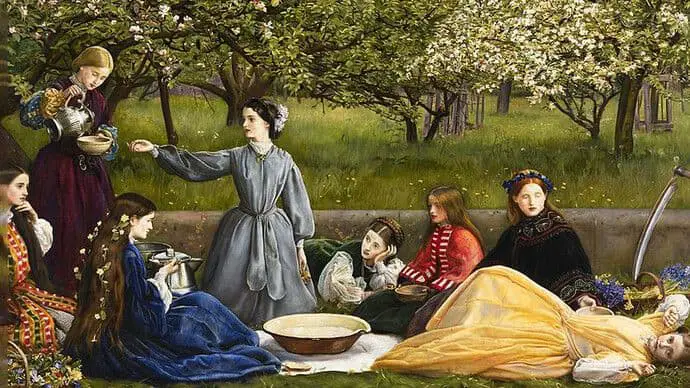What does nature symbolize in art?
Nature has long been a source of inspiration and symbolism in art. Across different cultures and time periods, artists have used elements of the natural world to represent ideas, emotions, spiritual beliefs, and more. Here are some of the key things that nature can symbolize in art:
Fertility and new life
Images of seeds, flowers, trees, and lush landscapes often symbolize fertility, new beginnings, and the cycle of life in artwork. Fruit and flowers represent the fulfillment of dormant potential, and the blossoming of seeds into new life. Trees with fresh spring growth also suggest rebirth and regeneration. Many ancient pagan cultures worshipped aspects of nature and used natural symbols relating to fertility in their rituals and artwork.
Some key natural symbols of fertility include:
– Flowers – Associated with spring, blooming, youth, and feminine energy. Common in floral still life paintings.
– Fruit – Ripened product of flowering plants, symbolizes fulfillment, abundance and harvest in art.
– Seeds – Represent dormant potential and the promise of future life.
– Trees – Evergreen trees suggest endurance and eternal life. Deciduous trees represent the seasonal cycle of death and rebirth.
– Eggs – Symbolize new life, birth, and emergence. May be depicted with hatching chicks.
– Gardens – Cultivated landscapes representing human control over the fertility of nature.
The divine and spiritual realm
Throughout history, scenes of untouched nature have been used to represent the divine in art. Natural landscapes untarnished by humans suggest realms beyond mortal existence and a spiritual plane of being.
Some ways nature depicts the metaphysical realm:
– Mountains – Can symbolize the ascent to spiritual heights and closeness to the divine.
– Sun – The heavens, divine light, and God’s grace. Sunrise invokes renewal.
– Clouds – Suggest the celestial realm and heavens beyond the earth.
– Stars – Eternal and unchanging, symbolic of divine presence. Guiding light for humanity.
– Water – Represents formlessness, infinity, reflection, and constancy in spirituality.
– Rainbows – Bridge between heaven and earth. A sign from the divine in myths.
Mortality and the passage of time
Artists also use nature as a reminder of the impermanence of life and inexorable passage of time. Changing seasons, wilting flowers, and weathering elements represent mortality, transience, and the effects of time. Vanitas paintings containing skulls, clocks, and decaying fruit convey the brevity of life and fruitlessness of earthly pleasures.
Some natural symbols of impermanence and time include:
– Falling leaves – Represent old age, decay, and impending death.
– Wilting flowers – Suggest the fleeting nature of beauty, life, and youth.
– Butterflies – Symbolize the soul emerging from its earthly vessel.
– Melting snow – Ephemeral, signifies the passing of winter.
– Setting sun – Indicates daily and life cycles ending.
– Eroded mountains/landscapes – Show the effects of time on the earth.
– Weathered wood – Visual reminder of nature reclaiming created things.
Emotions and the interior life
Elements of nature mirror emotions and inner psychological states in many artworks. Stormy seas reflect tumultuous feelings and darkness of the soul. Bright flowers can indicate joy and lightheartedness. Barbren landscapes mirror loneliness, grief, or despair. Natural symbols provide effective visual metaphors for intangible human experiences.
Some examples of nature representing emotions:
– Ocean – Powerful waves suggest passion. Calm waters evoke tranquility or melancholy.
– Storm clouds – Turbulence, anger, anxiety, or ominous events ahead.
– Lightning and thunder – Explosive rage or wrath.
– Fog – Blurred vision, confusion, veil between consciousness and unconscious.
– Desert – Barrenness symbolic of despair, spiritual dryness, loss, emptiness.
– Dark forests – Suggest the unknown, danger, mystery, the shadow self.
– Bright flowers – Joy, pleasure, happiness. Wilting/fading flowers indicate sadness.
Harmony between man and nature
Paintings and artworks depicting humans integrated harmoniously within their natural environment represent unity between man and the natural world. Wilderness landscapes unmodified by civilization show nature in its purest form, representing a paradise before man’s influence. Peaceful coexistence with nature symbolizes spiritual harmony in some cultures.
Some ways art shows harmony with nature:
– People resting blissfully in lush natural settings
– Natural backgrounds with no manmade structures
– Wholeness of humans interacting with animals
– Lack of boundaries between man and wilderness
– Natural objects integrated with human figures
– Earth colors like greens, browns, blues dominating palette
The wild and untamed
Wilderness settings removed from civilization represent the untamed power of nature through storms, rugged terrain, and predator animals. Dramatic landscapes and seascapes demonstrate raw natural force exceeding man’s control. Images of exotic jungles and faraway lands evoke the unknown. Dangerous creatures symbolize our primal instincts or the shadows of the psyche.
Examples of nature symbolizing the wild:
– Lightning – Uncontrolled, dangerous natural power
– Jagged mountains – Inhospitable, impassable terrain
– Volcanoes and earthquakes – Violent natural forces
– Savage seas – Waves dwarfing humanity’s vessels
– Predators – Power, dominance, survival instincts
– Jungles and exotic locations – Faraway, uncivilized realms
Conclusion
In summary, nature has been an essential source of symbolism in art across cultures and eras. It provides effective visual metaphors for life cycles, spirituality, emotions, and our relationship with the natural world. Whether depicting fertility, mortality, divinity, savagery or harmony, nature’s imagery conveys profound aspects of human experience and our connection to the environment. The timeless universality and resonance of natural symbols will ensure their enduring use in art as long as humanity exists.


